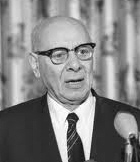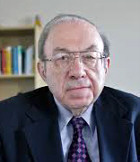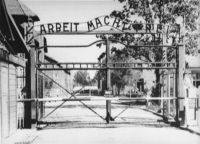

Did Jews Go Like Sheep to the Slaughter?
![]()
By Nechama Tec. Home / Winter 2013
Article Source

"Partisans In The Forest," Irene Lieblich, 1923–2008. Courtesy of Mahil Lieblich, © The Estate of Irene Lieblich, 2013.
Invariably, as a frequent lecturer on the Holocaust, I am asked variations of the cliché, Why did Jews go like sheep to the slaughter? Behind this question is a blatantly false assumption that the opportunities to resist were present, but Jews simply failed to take advantage of them mdash; in other words, the victims themselves were partly to blame for their own destruction.
Ironically, the phrase "like sheep to the slaughter" first appeared in the Holocaust context as a call to arms in a 1942 New Year's Manifesto in which Aba Kovner, a 23-year-old poet and Hashomer Hatzair (Socialist Zionist organization) leader in the Vilna ghetto, called for resistance: "Jews! Defend yourselves with arms! The German and Lithuanian hangmen have arrived at the gates of the ghetto. They have come to murder us! … But we shall not go! We shall not stretch our necks like sheep for the slaughter! Jews! Defend yourself with arms!" (Ghetto in Flames: The Struggle and Destruction of the Jews in Vilna in the Holocaust.)
How did Aba Kovner's anguished call to stand up to the enemies of the Jews later come to be used to accuse the Jews of participating in their own demise?
One of the early proponents of the view that Jews were somehow complicit in their own destruction was Bruno Bettelheim. A Jewish psychoanalyst from Vienna, he was charged by the Nazis for political transgressions, arrested in 1938, and incarcerated in various concentration camps. A year later, an American benefactor sent him a U.S. immigration visa and he was released.
In 1943, Bettelheim wrote a long article in Abnormal and Social Psychology about his life in the concentration camp. Claiming for himself the role of an objective observer, he emphasized the slave-like docility of concentration camp inmates.
Notably, however, during the time of his incarceration, all concentration camp inmates were being held on charges stemming from alleged political and/or criminal transgressions. It was not until 1942, three years after Bettelheim's release, that Jews and other groups were marked for extermination in death factories as part of Hitler's "Final Solution."

Bruno Bettelheim
In the early 1960s, Bettelheim returned to the theme that Jews had passively contributed to their own doom. Anne Frank, her family, and the Jews who had shared their hiding place in Amsterdam could, he said, "have provided themselves with a gun or two, had they wished. They could have shot down at least one or two of the 'green police' who came for them. There was no surplus of such police. The loss of an SS with every Jew arrested would have noticeably hindered the functioning of the police state. The fate of the Franks would not have been any different because they all died anyway except for Anne's father, (but)…they could have sold their lives dearly instead of walking to their death" (The Informed Heart, Avon, New York, 1960).
Clearly Bettelheim did not understand the insurmountable obstacles Jews faced under Nazi domination in the 1940s. Guns were unattainable. With very few exceptions Jews who sought to purchase weapons failed, and many who tried were murdered in the attempt.
Nonetheless, as a successful psychoanalyst, a talented writer, and someone who had presented himself as a Holocaust survivor, Bruno Bettelheim succeeded in being listened to, and his accusation of Jewish docility became an accepted view.
![]()
![]()
![]()
![]()
![]()

Raoul Hilberg
Another influential writer on the Holocaust was the historian Raoul Hilberg. In his magnum opus, The Destruction of the European Jews (first published in 1961, most recently updated in 2003), Hilberg wrote, "During the catastrophe of 1933–45, the instances of opposition were small and few. Above all, whenever and whichever they occurred, they were actions of last (never first) resort."
The book's descriptions of Jewish uprisings are brief, and critical facts do not appear. Ignored are the complexities, such as Jews being denied the means of armed resistance throughout the war. Weapons were scarce, and the Allies were unwilling to help Jews secure them. Successful resistance is contingent on the presence of several conditions, the key component being cooperation with others. Under German occupation, the emerging Jewish leaders searched in vain for cooperative parties, but none took interest in their plight or responded to their pleas for arms.
Effective armed resistance also requires guerillas to be able to vanish and blend into the local population mdash; but having been forced into Jewish ghettos, the vast majority of Jews in Eastern Europe had no place to hide.
Another precondition for successful resistance is effective leadership, and here, too, Eastern European Jewry was at a huge disadvantage. Many Jewish leaders were murdered during the first stage of the German occupation in 1939; only a few of the Judenräte (German-mandated Jewish Councils) wholeheartedly supported the Jewish underground; and most of the underground commanders lacked military experience.
Ignoring these overwhelming obstacles to Jewish armed opposition, Hilberg focused instead on one question: Did Jewish resistance diminish Germany's overall military power? And to that he answered: When "measured in German casualties [Jewish resistance]…shrinks into insignificance."
By that definition, he was right. Jews were never in a position to undermine or diminish the effectiveness of German military might. But is it appropriate to evaluate Jewish, or, for that matter, any other kinds of resistance, only in military terms? What about the ingenious strategies the Jews were continually devising in order to survive and record the heinous crimes committed by the Nazis and their collaborators? What about spiritual resistance?
Hilberg didn't even acknowledge that a military defeat of their oppressors was not the resisters' primary aim. The Jews were fully aware of German superior power, and their own powerlessness. Through opposition, they tried to achieve a certain measure of autonomy, to the point of choosing their way of dying. As Yitzhak Zuckerman, second in command of the Warsaw Ghetto uprising, commented, 25 years later: "I don't think there is any need to analyze the uprising in military terms. This was a war of [fewer] than a thousand people against a mighty army, and no one doubted how it was likely to turn out….If there is a school to study the human spirit, there it should be a major subject. The really important things were inherent in the force shown by Jewish youths, after years of degradation, to rise up against their destroyers and determine what death they would choose: Treblinka or Uprising. I don't know if there is a standard to measure that" (A Surplus of Memory, 1993).
In short, the goal of the Warsaw Ghetto revolt was not to win a military victory; it was to die fighting.
![]()
![]()
![]()
![]()
![]()
In 1963, influenced by Hilberg's writings, the journalist Hannah Arendt published Eichmann in Jerusalem, which, while covering the Eichmann trial, also portrayed the Jews as collaborators in their own destruction. Stating that "undoubtedly the darkest chapter of the whole dark story [the Holocaust]…has now been exposed….in all its pathetic and sordid detail by Raoul Hilberg," she went on to describe the Judenräteas cooperating with the Nazis in the destruction of their own people: "In the Nazi inspired, but not Nazi dictated manifestoes, they issued, we still can sense how they enjoyed their new power."
Influential as they were, Bettelheim, Hilberg, and Arendt all got it wrong. Bettleheim and Arendt built their cases on hypothetical value judgments and personal views rather than historical fact, and Hilberg took an incomplete and narrow view of Jewish resistance.
![]()
![]()
![]()
![]()
![]()
What is the truth about Jewish resistance during the Holocaust? While "resistance" conjures up images of combat; in reality, armed confrontations between oppressors and their victims during the war were rare, for the reasons noted above. In general, resistance efforts focused on collecting and disseminating information, forging documents, and accumulating arms where possible. The few national armed uprisings that did occur mdash; such as the 1944 revolt in Paris, when the Allies were already at the gates; and the August 1944 Warsaw uprising, which ended with the destruction of the city and the estimated death of 200,000 Poles mdash; occurred late in the war, when the Allied victory was imminent.
In my view, the unprecedented oppression of the Jews led to equally unprecedented forms of resistance, such as gemilut chasadim, acts of kindness. One example: On September 23, 1943, the day the final liquidation of the Vilna ghetto began, the population was divided by age and sex; however, older men were thrown into a group of older women and women with children. Dina Abramovicz, then a teenager, was watching from afar as her elderly mother struggled with oversized bundles. Suddenly, the Nazis pushed a teacher she knew into the group of older women and children because he walked on crutches. Faced with having to climb a hill along with the crowd, the teacher looked around imploringly, as if asking for help. Dina tells what happened next:
"Someone responded to his pleading and it was my mother. She put down all her bundles and took the arm of the crippled man, who leaned heavily on her. As they moved toward the steep hill together mdash; the tall, crippled man and the elderly, frail woman mdash; their faces glowed with a sublime light mdash; the light of compassion and humanity that overcame the horror of their destiny. This is the light in which I remember my mother and which will not disappear from my memory as long as I live."
 In the extreme environment of the concentration camp, resistance also often took the form of personal risks to support a newly made friend. A true story: Two young girls in Auschwitz became close friends. One of them developed a violent cough, and a kapo insisted she be moved to the Auschwitz medical ward, from which few returned alive. The healthy friend visited her every day after work, risking illness and being interned in the medical ward herself. Occasionally she would bring her friend water or a little slice of bread.
In the extreme environment of the concentration camp, resistance also often took the form of personal risks to support a newly made friend. A true story: Two young girls in Auschwitz became close friends. One of them developed a violent cough, and a kapo insisted she be moved to the Auschwitz medical ward, from which few returned alive. The healthy friend visited her every day after work, risking illness and being interned in the medical ward herself. Occasionally she would bring her friend water or a little slice of bread.
One day after work, she noticed a raspberry bush next to the road and was filled with the desire to bring the fruit to her friend. Knowing that if the Germans found out it would be confiscated and she would likely be murdered, she nonetheless gently placed the fruit into her closed palm in a leaf and then rushed to her friend with the news that she had a surprise. The raspberries, however, clutched tightly in her hand, had become a paste. Nevertheless, when the sick young girl saw what was in her friend's open palm, her face lit up with happiness. Such a gesture of kindness, an act of spiritual resistance, proved to each girl that she was not alone and rekindled her hope in humanity.
In examining the actions of the Jews during the Holocaust, it is important to view them in the appropriate context. The Holocaust scholar and survivor of the Lód'z Ghetto and Auschwitz Lucjan Dobroszicki reminds us of this when he asks: "Has anyone seen an army without arms? An army scattered over 200 isolated ghettos? An army of infants, old people, the sick? Armies whose soldiers are denied even the right to surrender?"
Equally important, we must not limit ourselves to a narrow definition of resistance. The charge that Jews were complicit in their own slaughter rings hollow when Jewish resistance is more broadly defined to include armed resistance, simple acts of kindness, ingenious survival strategies, and the commitment to retain one's own humanity in the face of overwhelming evil.
Nechama Tec is professor emerita of Sociology, University of Connecticut, Stamford, and author of several books on the Holocaust, including the bestselling Defiance. This article is adapted from Resistance, published in June 2013 by Oxford University Press.




































